APAH 250
1/252
There's no tags or description
Looks like no tags are added yet.
Name | Mastery | Learn | Test | Matching | Spaced |
|---|
No study sessions yet.
253 Terms
Apollo 11 stones. Namibia. c. 25,500–25,300 B.C.E.
FO: charcoal drawing on fragments of quartzite slab; prehistoric
FU: may have been used for religion/worship or storytelling; suggests modern behavior + transportation tech
CN: charcoal drawing depicting animal figure in profile, may be a common four-legged animal or a therianthrope (feline + human)
CX: discovered during apollo 11 moon landings (1969), radiocarbon dating
Great Hall of the Bulls. Lascaux, France. Paleolithic Europe. 15,000–13,000 B.C.E.
FO: natural pigment (charcoal, ochre) painting on rock, stone tools; prehistoric
FU: may have ritual significance for “hunting magic”
CN: various animals drawn big and in twisted perspective
CX: cave has long history, as shown by superimposed images
Camelid sacrum in the shape of a canine. Tequixquiac, central Mexico. 14,000–7000 B.C.E.
FO: carved sacrum (hip) bone from a camelid; prehistoric
FU: may have been a mask and/or related to creation mythology
CN: camelid sacrum carved to look like an animal skull
CX: later mesoamerican cultures viewed the sacrum as sacred
Running horned woman. Tassili n’Ajjer, Algeria. 6000–4000 B.C.E.
FO: pigment/engravings on rock; prehistoric
FU: most likely for a ritual/ceremony
CN: may depict a goddess in twisted perspective, judging from her horns, scars, and clothes
CX: located in a secluded area, may have been a sanctuary
Beaker with ibex motifs. Susa, Iran. 4200–3500 B.C.E.
FO: painted terracotta; prehistoric
FU: likely only meant for burial
CN: many animal depictions (birds, dogs, goats) + patterns
CX: one of many other Susa I pottery for burials; burials in the cemetery were secondary (buried after decomposing) and made about simultaneously
Anthropomorphic stele. Arabian Peninsula. Fourth millennium B.C.E.
FO: carved sandstone; prehistoric
FU: religion or burial (grave marker)
CN: abstracted human/anthropomorphic figure representing a trader
CX: 1/3 discovered, neolithic period
Jade cong. Liangzhu, China. 3300–2200 B.C.E.
FO: carved jade; prehistoric
FU: unknown, likely important in rituals/burials
CN: carved patterns/decorations, “face pattern” representing spirits/deities
CX: bi (disc) and cong (tube), difficult and time-consuming to make
Stonehenge. Wiltshire, UK. Neolithic Europe. c. 2500–1600 B.C.E.
FO: standing sarsen (silicified sandstone) pillars in a cromlech; built in 3 phases; prehistoric
FU: may have been a calendar (solstices) or a burial site, likely very important
CN: sarsen pillars erected in henge (circular ditch/bank) using post/lintel, heel stone marks solstice
CX: built in 3 phases over 500 years
The Ambum Stone. Ambum Valley, Enga Province, Papua New Guinea. c. 1500 B.C.E.
FO: greywacke stone carving; prehistoric
FU: may have been mortar/pestle; may have been sacred, may have been used in fertility ritual. nobody knows!!
CN: stone carved into an unknown animal form, may be an echidna
CX: used for religion by early papua new guineans
Tlatilco female figurine. Central Mexico, site of Tlatilco. 1200–900 B.C.E.
FO: small ceramic figure of a woman; prehistoric
FU: may have been used to represent fertility/duality or for religious rituals
CN: ceramic woman with exaggerated curves, two faces, elaborate hairstyle
CX: many found buried under residences
Terra cotta fragment. Lapita. Solomon Islands, Reef Islands. 1000 B.C.E.
FO: fragment of reddish-brown terracotta; formed by hand, incised/stamped with dentate/sharp edge; prehistoric
FU: part of a larger pot, probably for serving/storing food
CN: anthropomorphic patterns + geometric forms incised/stamped onto surface
CX: made by the Lapita people, known for their pottery and navigation abilities
White Temple and its ziggurat. Uruk (modern Warka, Iraq). Sumerian. c. 3500–3000 B.C.E.
FO: temple on top of mud brick ziggurat (platform w sloped sides); ancient near east (sumerian)
FU: religious structure
CN: white tripartite temple
very grand and powerful looking
located in city center
CX: likely built by ~1500 slaves over 5 yrs
Palette of King Narmer. Predynastic Egypt. c. 3000–2920 B.C.E.
FO: carved greywacke; ancient egypt
FU: ceremonial/ritual item for a god, likely for applying makeup to god’s image
may have represented unification of upper/lower egypt
CN: greywacke palette, carved in detail on both sides
scenes in registers depicting the king, seropards, bull heads, etc.
CX: found ritually buried in a temple. smaller less elaborate palettes could also be used in daily life
Statues of votive figures, from the Square Temple at Eshnunna (modern Tell Asmar, Iraq). Sumerian. c. 2700 B.C.E.
FO: painted gypsum, limestone, alabaster; inlaid w shell/black limestone; ancient near east (sumerian)
FU: likely intended for perpetual worship to the god Abu
CN: 12 statues varying in size and material
all have focused large eyes and clasped hands/holding cups (symbolic proportion)
CX: placed in the cella (waiting room) of temple, stylized version of the person they represent
Seated scribe. Saqqara, Egypt. Old Kingdom, Fourth Dynasty. c. 2620–2500 B.C.E.
FO: painted limestone w inlaid eyes; ancient egypt
FU: funerary sculpture
CN: non-idealized sculpture of a scribe
in a relaxed seated position with hands positioned to hold pen/papyrus
CX: less important = less need to be idealized. though he was still relatively important (as a scribe) since he got a statue
Standard of Ur from the Royal Tombs at Ur (modern Tell el-Muqayyar, Iraq). Sumerian. c. 2600–2400 B.C.E.
FO: wooden box-like object covered with bitumen and inlaid with shell/lapis lazuli/red limestone; ancient near east (sumerian)
FU: may have been a military standard or an instrument
CN:
use of registers and hierarchical scale
each side has 3 registers, represents war/peace. war depicts king, battlefield, war carts, etc. peace depicts king, agriculture, feast.
CX: two sides of sumerian kingship; military leader and human/god mediator
Great Pyramids (Menkaure, Khafre, Khufu) and Great Sphinx. Giza, Egypt. Old Kingdom, Fourth Dynasty. c. 2550–2490 B.C.E.
FO: cut limestone; ancient egypt
FU: burial for deceased pharoahs + important court members, protect body/possessions + symbolize power. sphinx is their guardian.
CN: 3 primary pyramids each with a temple at the base, sphinx statue, several smaller pyramids
CX: 3 pyramids were each built by a different ruler, pyramid shape represented sun’s rays
King Menkaure and queen. Old Kingdom, Fourth Dynasty. c. 2490–2472 B.C.E.
FO: carved greywacke; ancient egypt
FU: help ensure rebirth for the king in the afterlife, portray power + divinity
CN: statues of pharoah Menkaure and his queen (likely his mother); both figures are depicted with ideal youthful bodies and are striding forward (mutual respect + equality)
CX: found in Menkaure’s pyramid
The Code of Hammurabi. Babylon (modern Iran). Susian. c. 1792–1750 B.C.E.
FO: basalt stele; ancient near east (babylon)
FU: shows Hammurabi’s authority, first written law code
CN: law code stele of King Hammurabi listing 300 laws (cuneiform) + depicting god Shamash giving the king a scepter/ring (representing power)
CX: provided legal precedent for future law, “eye for an eye” system, show what was important (agriculture, family life, etc)
Temple of Amun-Re and Hypostyle Hall. Karnak, near Luxor, Egypt. New Kingdom, 18th and 19th Dynasties. Temple: c. 1550 B.C.E.; hall: c. 1250 B.C.E.
FO: cut sandstone and mud brick; ancient egypt
FU: principal religious center of god Amun-Re
CN:
very large temple for worship + working estate for priests + hypostyle hall (restricted access)
clerestory allows sunlight in
CX: one of the largest religious complexes in the world, grew as Thebes became more important
Mortuary temple of Hatshepsut. Near Luxor, Egypt. New Kingdom, 18th Dynasty. c. 1473–1458 B.C.E.
FO: sandstone partially carved into rock cliff, red granite; Ancient Egypt
FU: showed the authority of female pharoah Hatshepsut, allowed active worship
CN:
temple built directly against cliff, representations of her as a sphinx in the courtyard
does not contain her remains
CX: Hatshepsut was interested in using the arts to represent her power; commissioned portraits, statues, temples, etc. also assumed complete authority rather than being “king’s wife” or “king’s mother.” much art of her erased after her death
Akhenaten, Nefertiti, and three daughters. New Kingdom (Amarna), 18th Dynasty. c. 1353–1335 B.C.E.
FO: limestone, sunken relief; Ancient Egypt
FU: decoration, altar in domestic setting
CN: intimate portrayal of Akhenaten holding one daughter and Nefertiti the other two, blessing from Aten/divinity shown by sun’s rays
CX: beginning of Amarna style art (more naturalistic/curvilinear, deviates from “canon”/rectilinear); Akhenaton tried to change polytheistic religion to mono (only worshipping Aten)
Tutankhamun’s tomb, innermost coffin. New Kingdom, 18th Dynasty. c. 1323 B.C.E.
FO: solid golid, inlay of enamel/semiprecious stones; contained death mask (also gold); Ancient Egypt
FU: preserved Tut’s body to ensure safe passing into afterlife
CN: depicted as a god; gold skin, holds crook/flail (right to rule), goddesses carved. death mask is depicted wearing traditional royal dress and has a spell engraved on the back
CX: Tut was a very young king; two outer coffins were of wood and covered in gold
Last judgment of Hu-Nefer, from his tomb (page from the Book of the Dead). New Kingdom, 19th Dynasty. c. 1275 B.C.E.
FO: painted papyrus scroll; Ancient Egypt
FU: depicts Hunefer’s journey to the afterlife
CN: shows Hunefer going through various rituals after his death; opening mouth ritual, weighing heart, etc.
divided into registers, uses twisted perspective
CX: Hunefer was a royal scribe with high status; Book of the Dead was the “guide” showing the deceased how to get to the afterlife
Lamassu from the citadel of Sargon II, Dur Sharrukin (modern Khorsabad, Iraq). Neo-Assyrian. c. 720–705 B.C.E.
FO: carved alabaster; Ancient Near East (Assyrian)
FU: doorway sculptures to guard city/citadel gates and intimidate enemies, show king’s power
CN: very large lamassu (protective hybrid monster) statue
five legs to look still from front and walking from side; inscription between hind legs
CX: assyrians controlled ancient near east, kings set up many different palaces
Audience Hall (apadana) of Darius and Xerxes. Persepolis, Iran. Persian. c. 520–465 B.C.E.
FO: limestone; Ancient Near East (Persepolis/Persian)
FU:
show of persian/achaemenid king’s power (darius and xerxes)
connection to their gods/festivals,
administrative/economic center, more about the people (they bring offerings)
CN: large ceremonial building (audience hall + portico), 1000 sqm, 72 columns, two sets of engraved stairs depicting king + soldiers
CX: persepolis was the capital of achaemenid/persian empire, which controlled a vast territory
Athenian agora. Archaic through Hellenistic Greek. 600 B.C.E.–150 C.E.
FO: site plan of the agora (civic center) of athens; Ancient Greece (archaic-hellenistic)
FU: place for citizens to participate in government
CN: various buildings; temples, Stoa
CX: center of democracy, direct participation by citizens (athenian males), elections for leaders, various checks on power
Anavysos Kouros. Archaic Greek. c. 530 B.C.E.
FO: marble with remnants of paint; Ancient Greece (Archaic)
FU: grave marker for a soldier named Kroisos (would not have looked like him)
CN: nude kouros (young boy) sculpture with idealized body, symmetrical face, lifelike expression (archaic smile), elaborate hairstyle, one foot forward
CX: kouros depict greek ideal masculinity, used as grave markers or votive offerings
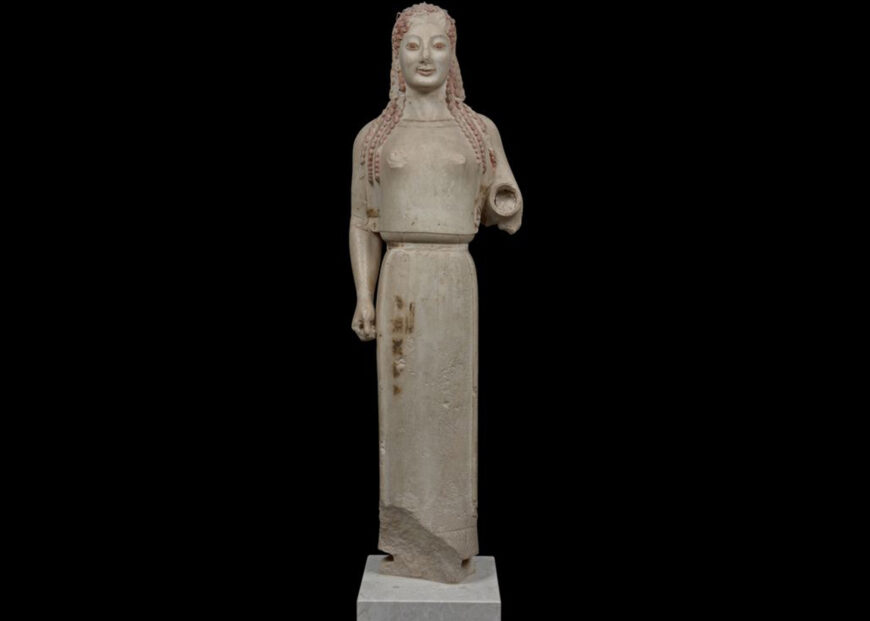
Peplos Kore from the Acropolis. Archaic Greek. c. 530 B.C.E.
FO: marble with painted details; Ancient Greece (archaic)
FU: kore (kouros counterpart) were often offerings to athena or a sculpture of a goddess (artemis)
CN: statue of ideal young woman w archaic smile holding something unknown (maybe a bow). originally believed to be a kore (kouros counterpart) wearing a peplos; now believed to be of artemis. clothing is probably not peplos; may have originally been decorated with animals. holes in head suggest a diadem
CX: found in Acropolis (dedicated to gods), buried in a pit following invasions
Sarcophagus of the Spouses. Etruscan. c. 520 B.C.E.
FO: anthropoid (human-shaped) painted terracotta sarcophagus; Etruscan
FU: contained remains of husband and wife
CN: stylized sarcophagus depicting man/woman reclining on a kline (dining couch), both w detailed hair/clothing
CX: men/women recline and eat together at Etruscan banquets, women had higher status than greek/roman women and can have public lives
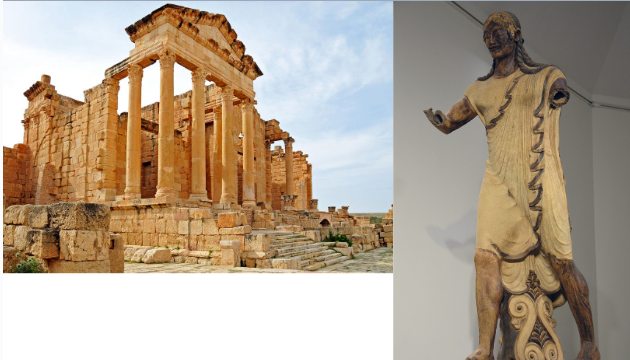
Temple of Minerva (Veii, near Rome, Italy) and sculpture of Apollo. Master sculptor Vulca. c. 510–500 B.C.E.
FO: Original temple of wood, mud brick, or tufa (volcanic rock); terracotta sculpture.
FU: worship
CN: temple has many columns and three rooms (divine triad), contained many terracotta sculptures including that of Apollo. Originally would’ve been placed on the temple roof as a tableau, depicting a contest between him and Hercules over the Golden Hind (deer sacred to Artemis)
CX: many Etruscan temples have vanished, appearances reconstructed from Vitruvius’s (Roman architect) descriptions
Tomb of the Triclinium. Tarquinia, Italy. Etruscan. c. 480–470 B.C.E.
FO: single tufa chamber, fresco-painted walls; Etruscan
FU: contain remains of deceased + grave goods/offerings to them
CN: scenes depict banquet, music, dancing; lively mood
CX: Etruscan funerals were festive, meant to share a final meal with the deceased + reinforce deceased’s family’s social standing
Niobides Krater. Anonymous vase painter of Classical Greece known as the Niobid Painter. c. 460–450 B.C.E.
FO: clay, red-figure technique w white highlights; Ancient Greece (severe period)
FU: mix wine and water
CN:
depicts mortal Niobe and her 14 children being killed by Artemis/Apollo after Niobe bragged that her children were more beautiful than them
attempt at depth with figures placed on different ground levels
CX: created in “severe style,” when archaic was transitioning to classical
Doryphoros (Spear Bearer). Polykleitos. Original 450–440 B.C.E.
FO: roman marble copy of a greek original statue (bronze); Ancient Greece (classical)
FU: for athletes to aspire to, established “canon” defining greek ideal beauty proportions (mathematical ratios, balance, harmony)
CN: marble sculpture of ideal male figure, more natural/asymmetrical stance (contrapposto); original would not have the stands + would have spear in left hand
CX: displayed in a place where athletes work out
Acropolis. Athens, Greece. Iktinos and Kallikrates. c. 447–410 B.C.E.
FO: many temples, main attraction is the Parthenon; Ancient Greece (classical)
FU: athens’s citadel, place of worship dedicated to Athena
CN:
main temple: Parthenon, made of marble and dedicated to Athena
small distortions for illusion of perfection, many pillars, sculpted metopes depict humans vs centaurs representing Greeks vs Persians
CX: “new Parthenon” rebuilt after destroyed by Persians in Persian War on top of old foundation and with some old salvaged materials
Grave stele of Hegeso. Attributed to Kallimachos. c. 410 B.C.E.
FO: marble and paint; Ancient Greece (classical)
FU: grave marker for Hegeso, daughter of Proxenos
CN:
a woman is presented with a necklace (once painted) by her servant
solemn, quiet mood
shape of the stele resembles a home, where women “belong”
CX: in the High Classical style; women are defined by relationships with men
Winged Victory of Samothrace. Hellenistic Greek. c. 190 B.C.E.
FO: parian marble statue; Ancient Greece (hellenistic)
FU: commemorate naval military victory at samothrace, possibly over the island at Rhodes
CN: Nike (goddess of victory) alighting/descending on a warship, possibly holding victory wreath; wet-looking and blowing drapery imply interaction w environment
CX: may have been located in a fountain
Great Altar of Zeus and Athena at Pergamon. Asia Minor (present-day Turkey). Hellenistic Greek. c. 175 B.C.E.
FO: marble architecture and sculpture; Ancient Greece (hellenistic)
FU: may allude to pergamene victory over barbarians in asia minor
CN:
Π-shaped structure with columns + grand staircase
wrapped with 113m long relief carvings depicting gigantomachy
extremely dramatic and emotional, comes out of the wall and invades viewer’s space
CX: gigantomachy refers to the mythological battle between gods of Olympus and giants for control of the world, mainly involving Athena/Zeus/Heracles vs Alkyoneos
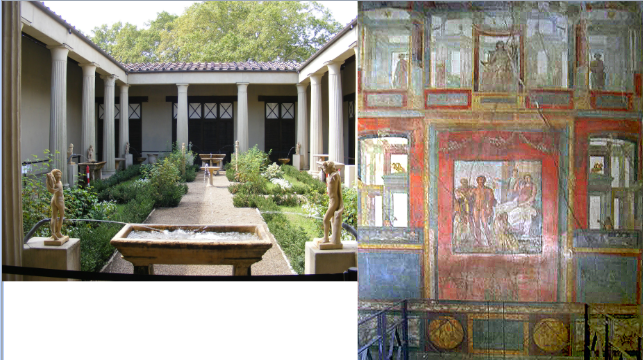
House of the Vettii. Pompeii, Italy. Imperial Roman. c. second century B.C.E.; rebuilt c. 62–79 C.E.
FO: cut stone and fresco; Ancient Rome (pompeii)
FU: dwelling, reinforce social standing; shows aesthetics of city right before destruction
CN: 1100sqm, wall painting, standard Roman house architectural elements
CX: owned by wealthy former slaves Aulus Vettius Conviva and his brother Aulus Vettius Restitutus
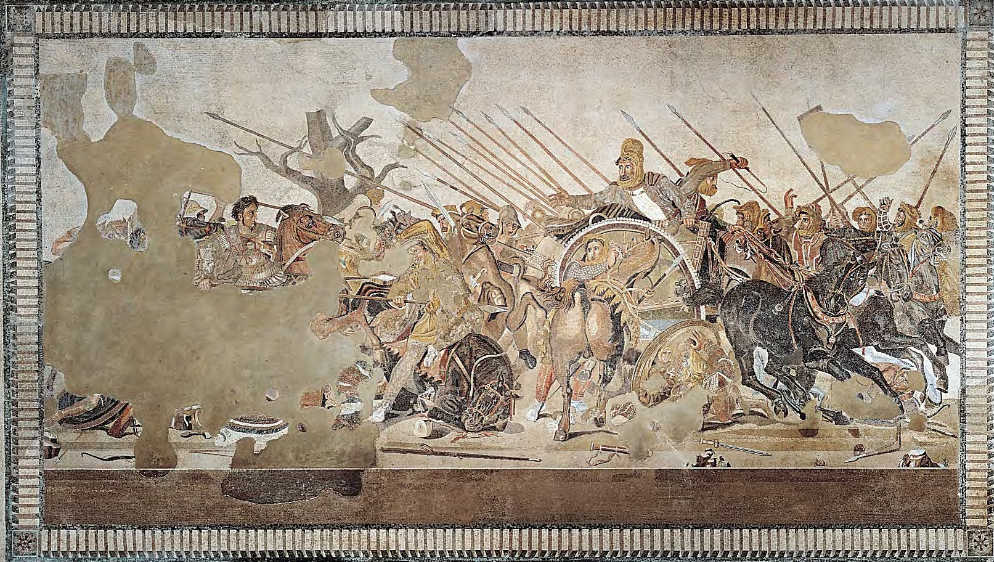
Alexander Mosaic from the House of Faun, Pompeii. Republican Roman. c. 100 B.C.E.
FO: Roman mosaic copy of Greek wall painting, 1.5 million pieces of tesserae; Ancient Greece (hellenistic)
FU: Roman copy originally on the floor, meant to impress and show house owner’s high education in greek culture
CN: depicts Alexander the Great’s victory in the Battle of Issus against Darius III
Alexander charging forward, soldier taking the blow meant for Darius as his charioteer turns around
detailed, naturalistic, light/shadow (modelling), foreshortening
CX: found in Pompeii’s largest residence, preserved by the ash layers
Seated boxer. Hellenistic Greek. c. 100 B.C.E.
FO: original bronze sculpture; Ancient Greece (hellenistic)
FU: expansion of Hellenistic period (ideal body, but more human emotions depicted through posture, expression, age), meant to evoke sympathy/pathos
CN: extremely human-feeling look to it; less dramatic, informal/slouched seated posture, age, weariness, scars
CX: many bronze Greek statues were melted down, this one of few Greek originals surviving
Head of a Roman patrician. Republican Roman. c. 75–50 B.C.E.
FO: marble portrait head; Ancient Rome (republican)
FU: convey gravitas (seriousness)/virtue of a public career
CN: Roman aristocrat with exaggerated signs of age (sagging, wrinkles), improve public image by making one seem wise and having veristic tendencies
CX: veristic style (hyperrealism w exaggerated features)
Augustus of Prima Porta. Imperial Roman. Early first century C.E.
FO: marble statue; Ancient Rome (early empire)
FU: propaganda-y; portray emperor augustus as a great/godlike military/civic leader + supporter of roman religion, young + perfect.
CN:
Augustus w ideal body + strong pose
cupid + dolphin next to him symbolize divinity
carvings on breastplate symbolize divinity, military victory, pax romana
CX: inspired by greeks; ideal form, contrapposto, heroic pose, divine
Colosseum (Flavian Amphitheater). Rome, Italy. Imperial Roman. 70–80 C.E.
FO: stone and concrete, barrel/groin vaults + arches; Ancient Rome
FU: amphitheater used for animal hunts, gladiator hunts, mock naval battles, etc (entertainment for the people)
CN:
seats for 70k people (seat level corresponds with social status)
complex corridor/stairway system, wooden arena, trapdoors/elevators to bring in animals and stuff
top to bottom is Corinthian order, Ionic order, Tuscan order
CX: bad condition due to earthquakes/pillaging. colosseum bc originally had a colossus statue
Forum of Trajan. Rome, Italy. Apollodorus of Damascus. Forum and markets: 106–112 C.E.; column completed 113 C.E.
FO: brick/concrete/stone architecture, marble column; Ancient Rome (high empire)
FU: forum was a public urban square for civic/ritual stuff; column showed the story of trajan’s campaign
CN: stone buildings, brick libraries, main square (area fori), Trajan temple, Column of Trajan (depicting trajan’s campaigns/victory against Dacia, 19 carved marble drums), statues, Markets of Trajan
CX: last of rome’s “imperial fora” (construction unique under the heavens), designed by apollodorus of damascus
Pantheon. Imperial Roman. 118–125 C.E.
FO: stone/concrete/marble w facing + columns (granite “spolia” from Egypt); Ancient Rome (high empire)
FU: temple dedicated to all the ogds
CN:
built with ideal/exact radial geometry
porch in front; dome building in back,
light entering through oculus represents meeting of heaven/earth
coffers (sunken decorative panels), square floor panels contrasting round dome/walls
CX: might have been designed by apollodorus of damascus. Current one is a copy finished during Emperor Hadrian’s time of those one built by Marcus Agrippa
Ludovisi Battle Sarcophagus. Late Imperial Roman. c. 250 C.E.
FO: marble, 5 feet; Ancient Rome (late empire)
FU: sarcophagus (burial) of someone wealthy/important
CN:
Romans portrayed with helmets and as ideal/heroic (“good guys”)
barbarians are helmetless and have a wild look to them (“bad guys”)
helmetless man in the middle is also a Roman, is the “hero.”
CX: late imperial sculpture; decline in art/stylistic shift represented dissolution of rome. distinguished by tight/crowded compositions pushed forward, stocky proportions
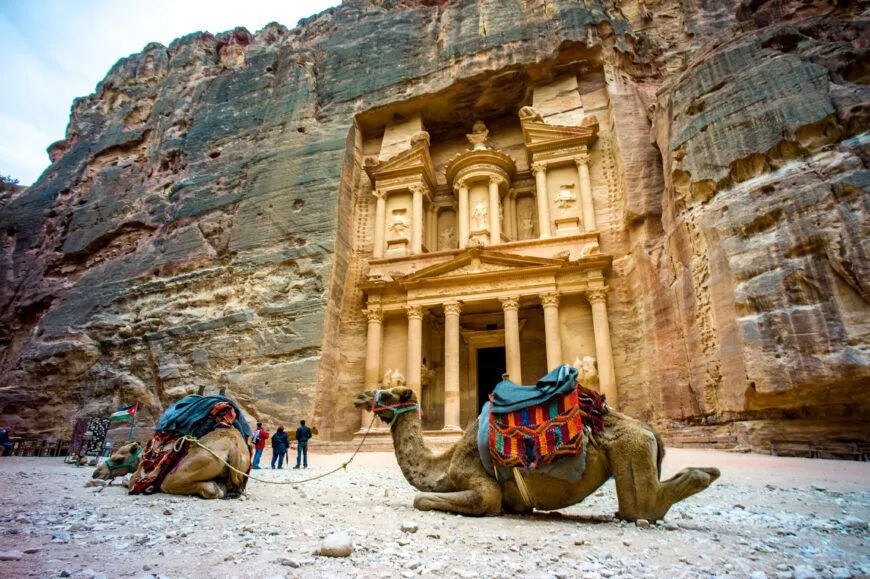
Petra, Jordan: Treasury and Great Temple. Nabataean Ptolemaic and Roman. c. 400 B.C.E.–100 C.E.
FO: cut rock; Ancient Rome (high empire)
FU: nabataean city (capital of their kingdom)
CN: buildings hand-chiseled into cliffsides, including tombs, temples, banquet halls, altars, etc
CX: became very wealthy due to location (intersecting trade routes), allowed for awesome! architecture such as this + irrigation/reservoirs for farming
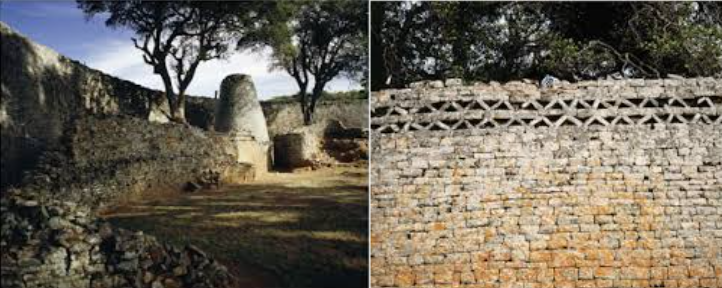
Conical tower and circular wall of Great Zimbabwe. Southeastern Zimbabwe. Shona peoples. c. 1000–1400 C.E.
FO: coursed granite blocks
FU: ceremonial gathering in the royal residence, preserve royal privacy, unknown use for conical stone structures (may have been silo, phallic symbol, etc)
CN: massive thick stone walls undulating across 1800 acres, included royal residence, conical stone structures (male/female)
CX: people were very advanced, economy based on cattle farming
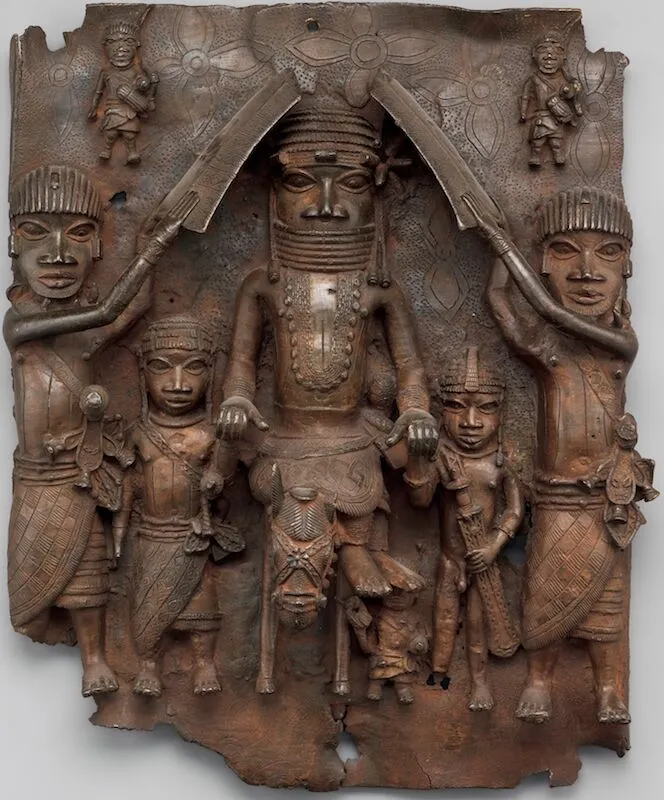
Wall plaque, from Oba’s palace. Edo peoples, Benin (Nigeria). 16th century C.E.
FO: cast brass
FU: record hierarchies + status, expression of royal power
CN: oba (king) displayed in center, use of hierarchical scale to emphasize power; symbolic proportion (large head) to represent wisdom
CX: one among many wall plaques of each Benin Oba in the royal lineage, order of placement corresponds to order of lineage
Sika dwa kofi (Golden Stool). Ashanti peoples (south central Ghana). c. 1700 C.E.
FO: gold over wood and cast-gold attachments
FU: believed to have been made in/fell from the heavens, soul of the Asante nation + more sacred than the king
CN: stool made of gold, usually laid on its side (so nobody sits on it) on its own stool
CX: stools are used as coming-of-age presents. golden stool was hidden from british when they demanded it, so it remains in asante possession
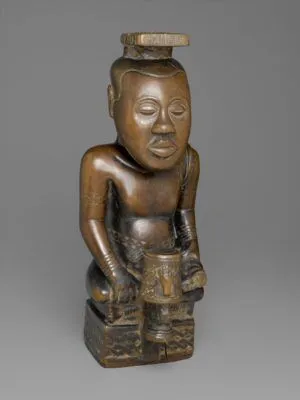
Ndop (portrait figure) of King Mishe miShyaang maMbul. Kuba peoples (Democratic Republic of the Congo). c. 1760–1780 C.E.
FO: wood
FU: representation of ideal king, spiritual power + historical marker (help record oral history)
CN: larger head = “seat of wisdom” (symbolic proportion), geometric motif/emblem linked to a specific leader (this one is drum w severed hand)
CX: ndop statues are a genre depicting important kuba leaders from 18th-20th centuries
Power figure (Nkisi n’kondi). Kongo peoples (Democratic Republic of the Congo). c. late 19th century C.E.
FO: wood and metal
FU: contain/release spiritual forces, mediate between spiritual/living. heal, protect, reminder of social obligation. spiritual specialist carves + activates through chants, prayers, sacred substances to “cure” physical/social/spiritual ills
CN: wooden figure (human/animal) with wide eyes/stance, hole represents “other world,” insertions represent type/degree of issue resolved
CX: Kongo people believe deeply in sacred medicine/divine protection, great god Ne Kongo brought the first sacred medicine
Female (Pwo) mask. Chokwe peoples (Democratic Republic of the Congo). Late 19th to early 20th century C.E.
FO: wood, fiber, pigment, metal; carved by a man, often modeled after a woman he admires
FU: worn (by a man) during ritual dance to honor women after childbirth, teach boys how to behave around women; model ideal womanhood (appearance/behavior) is; represent wisdom, beauty, introspection
CN: mask of woman with closed eyes/mouth,
CX: matrilineal; pwo is fertility deity
Portrait mask (Mblo). Baule peoples (Côte d’Ivoire). Early 20th century C.E. Wood and pigment.
FO: wood and pigment
FU: used in performances/skits in tribute to distinguished members (ex. elders), conduits (communicate w ancestors/spirits)
CN: made as a representation/in honor of someone else
CX: only higher class people can wear, must connect spiritually before painting
Bundu mask. Sande Society, Mende peoples (West African forests of Sierra Leone and Liberia). 19th to 20th century C.E.
FO: wood, cloth, fiber; carved by men
FU: part of masquerade dancing tradition performed by girls coming of age( dancer represents sowo water spirit)
reflect traits of ideal woman/wife/mother
CN: downcast eyes, serene expression (reservedness); small mouth/ears (no gossip); fat rolls (fertility); shiny black skin; beard (attaining knowledge equal to men)
CX: tradition also involved painting girls white, fattening them, and teaching how to be good wives/mothers
Ikenga (shrine figure). Igbo peoples (Nigeria). c. 19th to 20th century C.E.
FO: wood
FU: personal god of human endeavor; bring wealth, protection, fortune; represent power/authority of its owners, integral part of their identity and is to be honored
CN: male w curved horns holding a knife in right hand
CX: ikenga = “place of strength” + right hand (“hand of accomplishment”) placed in a personal shrine + seated on a stool, offer blood/food to it
Lukasa (memory board). Mbudye Society, Luba peoples (Democratic Republic of the Congo). c. 19th to 20th century C.E.
FO: wooden board covered with beads, metal, shells
FU: mnemonic device for court historians to remember events/people/places/lore/royal lineage
CN: board with tactile qualities to prompt memory; ex. deep engravings, carved geometric designs, bead clusters/lines, etc
CX: no written language but were still able to remember and record important events/people/information
Aka elephant mask. Bamileke (Cameroon, western grassfields region). c. 19th to 20th century C.E.
FO: wood, woven raffia, cloth, beads/cowrie shells (expensive material)
FU: convey power of fon (king), perform at public celebrations/funerals related to kuosi or fon
CN: elaborate beaded elephant mask with qualities of powerful animals (elephant ears, leopard stripes)
CX: kuosi was a society of powerful people (ex. royalty, court officials)
Reliquary figure (byeri). Fang peoples (southern Cameroon). c. 19th to 20th century C.E.
FO: wood
FU: talisman (ward off evil), guard reliquary (contain important objects/remains of important people, house relics); also used as puppets for male initiation
CN: form of basic shapes; calm + dignified expression (closed eyes/mouth); protruding navel = life-giving (symbolic proportion)
CX:
conceptual, portray idea of reliquary rather than a naturalistic figure. could be either male or female
fang peoples are migratory; made of light materials for easy transportation along with people’s remains
Veranda post of enthroned king and senior wife (Opo Ogoga). Olowe of Ise (Yoruba peoples). c. 1910–1914 C.E.
FO: wood (hand carved from one piece) and pigment
FU: made to decorate an entryway, would have been one of five veranda posts
CN: king sitting on throne, senior wife standing behind him for support, three smaller figures (one missing) are junior wife + musician. bulging eyes represent conduit, wife’s size shows her status, king’s central position + feet off the floor + crown show his
CX: female nude represents fertility for Yoruba; made by master carver Olowe of Ise
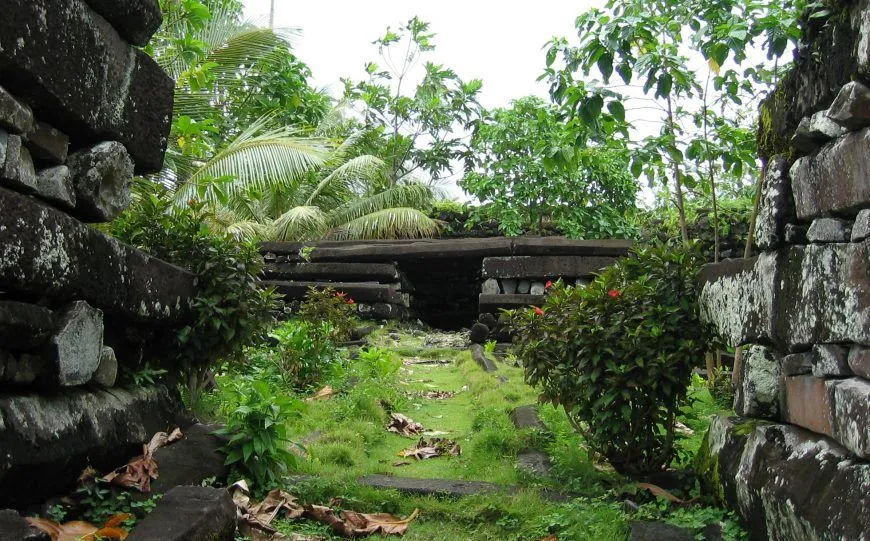
Nan Madol. Pohnpei, Micronesia. Saudeleur Dynasty. c. 700–1600 C.E.
FO: carved volcanic basalt boulder structures built on a coral reef, weighs 750k tons. criss-cross pattern of hor/perp pillars
FU: capital of Sau Deleur dynasty, power display (hard and expensive to build, food and water must be brought in)
CN: 100 rectilinear islets across 200 acres, canals, royal mortuary tomb.
CX: builders quarried 5-50 ton stones from the other side of Pohnpei, transported 25 miles and used ropes/levers to put in place.
Moai on platform (ahu). Rapa Nui (Easter Island). c. 1100–1600 C.E.
FO: volcanic tuff + basalt figures on basalt base
FU: embody/commemorate ancestors, ancestral connection/bridge, allow “conversations” through ritual/ceremony
CN: 14 stone statues of human figures (moai) of increasing size/complexity. heavy brows, long ears, protruding nipples, thin arms, carving on back. originally painted red/white + inlaid coral eyes
CX: religion based on ancestor worship evolved into “birdman” religion; moai marked spots with fresh water
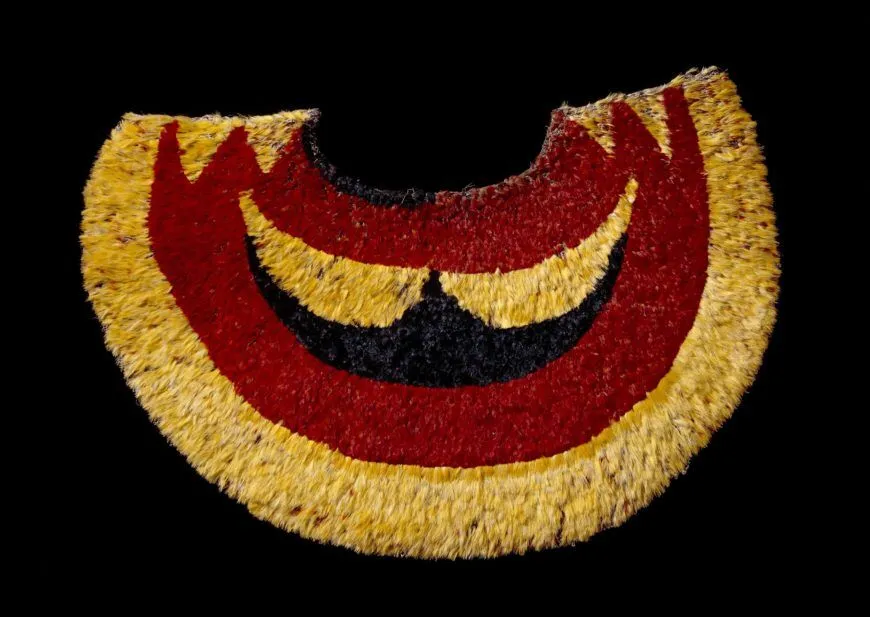
‘Ahu ‘ula (feather cape). Hawaiian. Late 18th century C.E.
FO: feathers, fiber
FU:
worn by male nobility for ceremonies/battles to intimidate
elite status symbol + sacred object demonstrating owner’s mana (sacred force) and tapu (protection) + king’s divinity
CN: cape made of red and yellow feathers
feathers + red associated with divinity
yellow is rare and valuable
CX: when making, artist chants wearer’s geneaology to imbue power; act of twining feather is sacred

Staff god. Rarotonga, Cook Islands, central Polynesia. Late 18th to early 19th century C.E.
FO: wood, tapa, fiber, and feathers
FU: represent deities, embody reproductive qualities. bottom phallus represents Tangaroa (fertility god). overall represents goal of survival and building future gens
CN: staff wrapped in barkcloth (protects its spiritual force, deity would leave w/out it), red feathers/pearls + layers represent mana (spiritual force
CX: some missionaries destroyed, seeing them as obscene
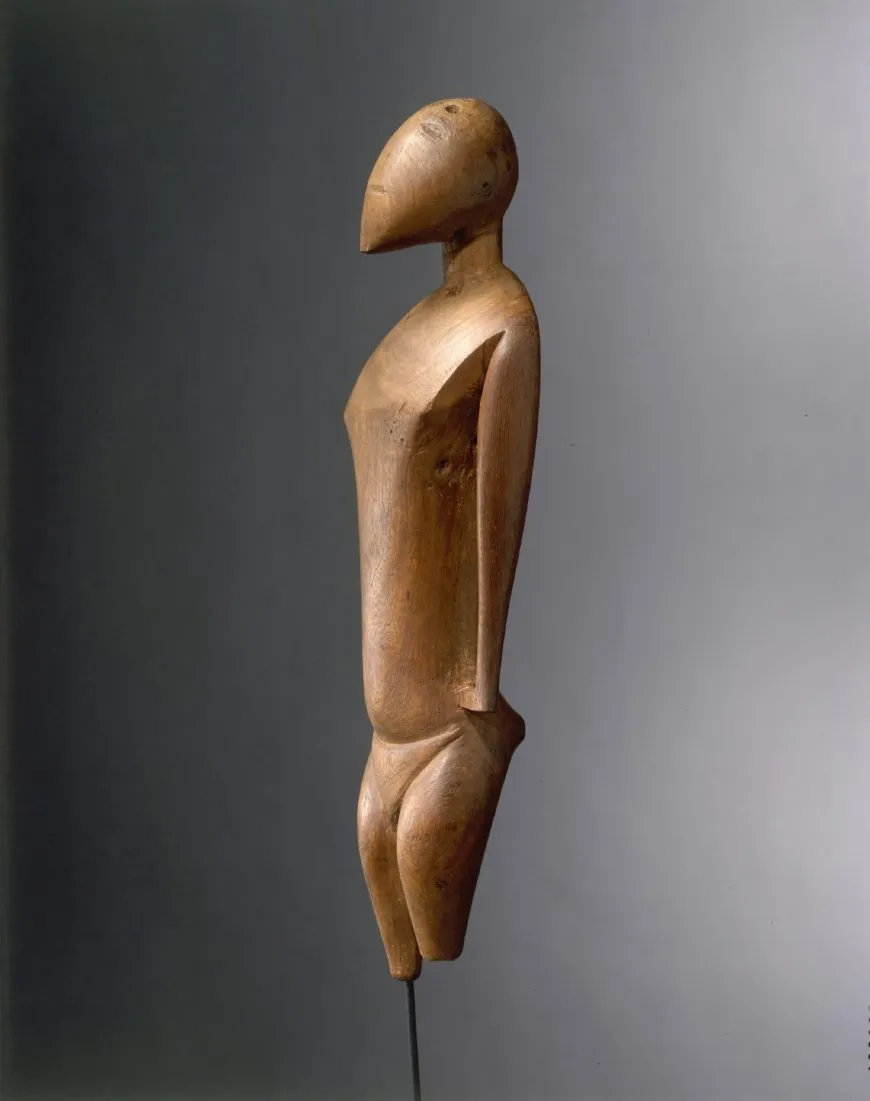
Female deity. Nukuoro, Micronesia. c. 18th to 19th century C.E.
FO: wood
FU: resting place for god/ancestor. kept in temples, decorated, offered food
CN: stylized smooth wooden figure w ovoid head, indication of chest/limbs
CX: divinity connected to genealogy, each figure associated w family, priest, temple
Buk (mask). Torres Strait. Mid- to late 19th century C.E.
FO: turtle shell, wood, fiber, feathers, shell
FU: mask/helmet to be worn during funerals, male initiation, rituals; allow wearer access to spirits
CN: composte of human/animal form
CX: often worn (like a helmet + w grass costume) by important men, often reenact historical events
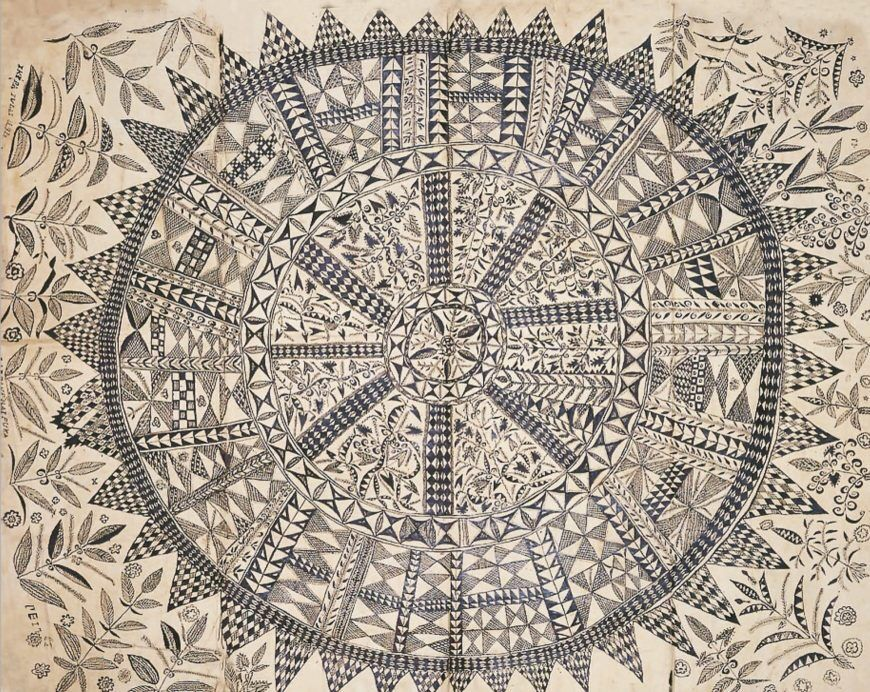
Hiapo (tapa). Niue. c. 1850–1900 C.E.
FO: tapa/bark cloth, freehand painting. bark cloth made by women beating bark flat with a wooden tool, designs through pounding, painting, or stencils
FU: ceremonially displayed, worn on/gifted special occasions, wrap sacred objects, decorated for people of rank
CN: painted geometric/nature motifs/patterns on bark cloth
CX: textiles are considered women’s art

Tamati Waka Nene. Gottfried Lindauer. 1890 C.E. Oil on canvas.
FO: oil on canvas depicting indigenous chief/war leader Tamati Waka Nene
FU: embodiment of tamati waka nene, not just a representation
CN: various aspects indicate status (kiwi feathers, paua eye, facoail tattoos)
CX: this and other similar portraits are cherished and treated w great respect by descendants

Navigation chart. Marshall Islands, Micronesia. 19th to early 20th century C.E.
FO: wood and fiber
FU: mnemonic devices to help ri-metos (navigators) memorize sea routes
CN: chart of wooden sticks; hor/ver are supports, diagonal are wave swells, shells are islands
CX: prized social items passed through generations, would not be taken on voyages because they were so valuable
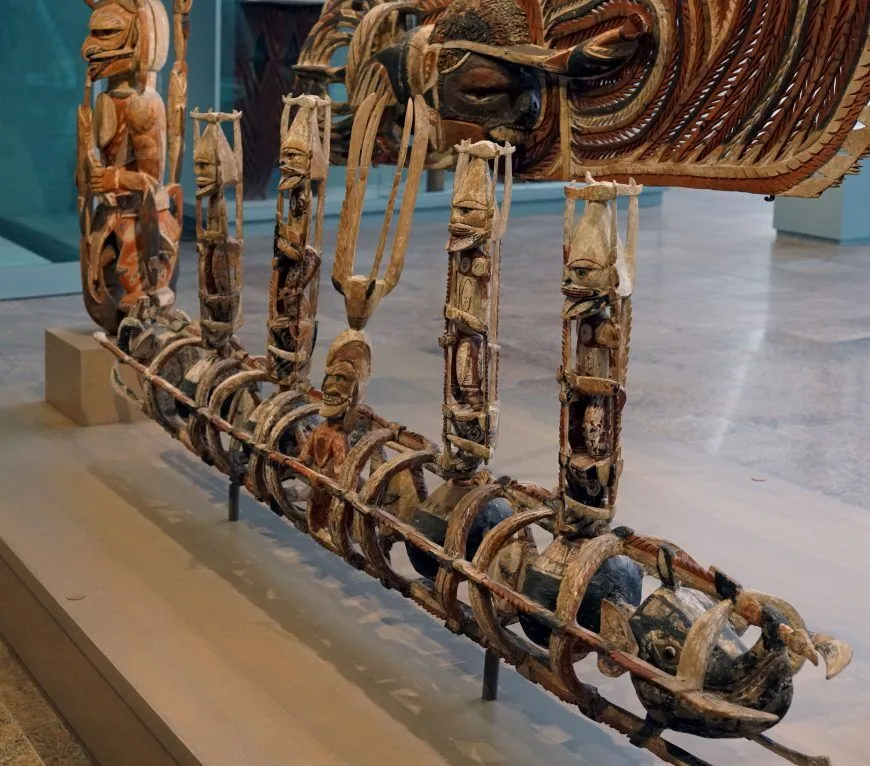
Malagan display and mask. New Ireland Province, Papua New Guinea. c. 20th century C.E.
FO: wood, pigment, fiber, shell
FU: used for rituals in funerals/mortuary feasts to help spirits transition to afterworld and bid farewell + celebrate living; affirmation of clan group identities. can represent various things: ancestors, bush spirits, spiritual doubles
CN: intricately carved mask, board, pole, mat, canoe, etc., each with a unique pattern
CX: each one is unique, no two look the same. meant to be destroyed to help souls leave
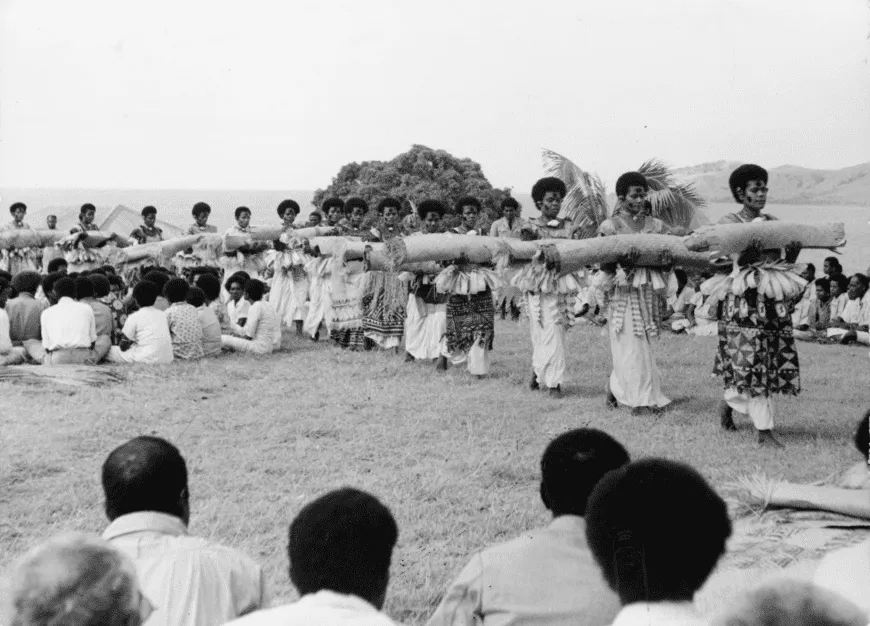
Presentation of Fijian mats and tapa cloths to Queen Elizabeth II. Fiji, Polynesia. 1953 C.E.
FO: multimedia performance (costumes, cosmetics, photographic documentation)
FU: honor and welcome queen elizabeth
CN: women wearing barkcloth skirts, carrying woven mats
CX: newly crowned queen elizabeth arrived in fiji on tour of commonwealth, was presented with various valuable traditional gifts, witnessed performances and ceremonies
Catacomb of Priscilla. Rome, Italy. Late Antique Europe. c. 200–400 C.E.
FO: excavated tufa (soft material) and fresco, stacked passageways up to 3 stories deep; late antiquity
FU: contain bodies + possessions (like a reliquary)
CN:
miles of underground catacombs filled with bodies (no longer there bc grave robbing)
fresco paintings: beginning of christian iconography, continuous narrative some naturalism
CX: most bodies (poor) placed in loculi (holes cut in the walls), then covered + painted
Santa Sabina. Rome, Italy. Late Antique Europe. c. 422–432 C.E. 26
FO: brick/stone, wooden roof, plain outside; late antiquity
FU: basilican christian church, congregational worship (attention focused in one direction, gender divisions)
CN:
clerestory windows: allow light
arcades: series of arches
nave + roman corinthian columns (spolia) focus attention on apse framing the altar
CX: modeled after roman basilica (law court), adapted bc it provided congregation room
Rebecca and Eliezer at the Well and Jacob Wrestling the Angel, from the Vienna Genesis. Early Byzantine Europe. Early sixth century C.E.
FO: Illuminated manuscript (tempera, gold, and silver on purple vellum); byzantine
FU: religious prestige object owned by wealthy, either to display or for education
CN:
depicting biblical stories in early medieval style (continuous narrative, distorted perspective, squat figures)
rebecca offering eliezer (looking for a wife for abraham) water
jacob encounters angel, starts being called israel
syncretism, combined ancient world art techniques w christian content
CX: colors are now faded, would’ve been silver text on purple (royal color) w brighter illuminated image.
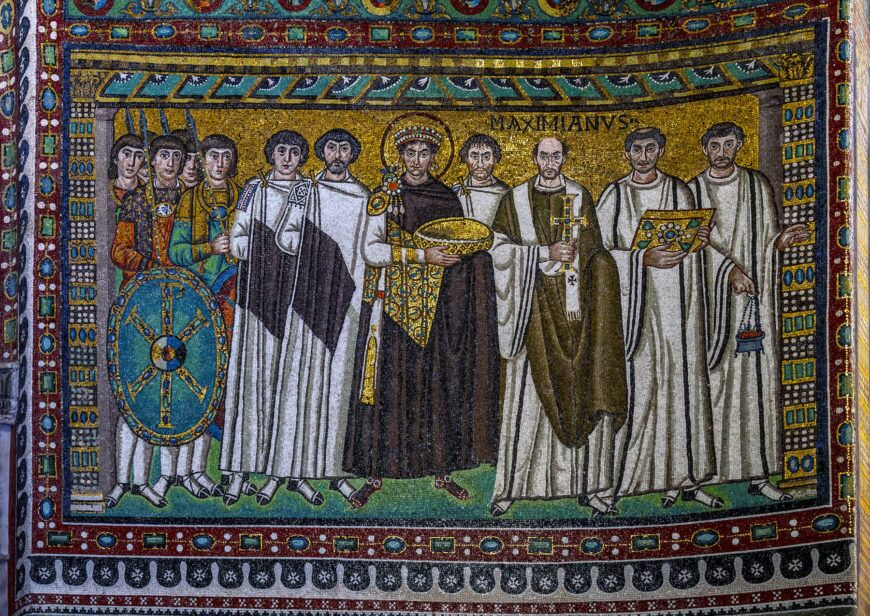
San Vitale. Ravenna, Italy. Early Byzantine Europe. c. 526–547 C.E.
FO: brick, marble, and stone veneer; mosaic.
FU: represent Justinian’s central authority (military, religious, administrative) + duties as emperor (restore territorial boundaries, establish religious uniformity)
CN:
centrally planned, two concentric octagons, plain exterior/elaborate interior, arches, squinches
mosaics of Justinian and Theodora
flat, frontal, floating, hieratic, symmetrical
surrounded by clergy/military: emperor’s military/religious roles
gold + purple + halo: god-given right to rule
proxy for emperor/ess
CX: built after roman empire split
Hagia Sophia (Holy Wisdom). Constantinople (Istanbul). Anthemius of Tralles and Isidorus of Miletus. 532–537 C.E.
FO: brick and ceramic elements with stone and mosaic veneer
FU: religious mosque for several different religions over time (now a museum)
CN:
plain exterior/elaborate interior
centrally + axially planned (primary central space + longitudinal organization)
40 windows let in light, create an abstract kaleidoscope effect
many mosaics
CX: Justinian/Theodora built in response to Nika Riots to create the “best church” + employ the rioters
Merovingian looped fibulae. Early medieval Europe. Mid-sixth century C.E.
FO: silver gilt worked in filigree, with inlays of garnets and other stones; early medieval
FU: brooches (hold cloak/cape in place), enhance prestige/stature (often buried w owners)
CN: zoomorphic shapes in abstract geometric designs. cloisonné (inlaid semi-precious stones)
CX: “barbarian” referred to non-roman immigrants in west EU, eagles and cloisonné popular
Virgin (Theotokos) and Child between Saints Theodore and George. Early Byzantine Europe. Sixth or early seventh century C.E.
FO: encaustic (pigments + hot wax burned to inlay) on wood
FU: small and portable icon for individual worship
CN:
virgin mary and baby jesus in the center; two angels looking up at light + god’s hand in the back
all figures have halos, are expressionless and frontal
few background details, compressed space
CX: in the late antique (focus on spiritual world) and hieratic (formal/stylized) style.
Lindisfarne Gospels: St. Matthew, cross-carpet page; St. Luke portrait page; St. Luke incipit page. Early medieval (Hiberno-Saxon) Europe. c. 700 C.E.
FO:
illuminated manuscript (ink, pigments, and gold on vellum)
early medieval/hiberno-saxon: christian imagery + animal interlace
horror vacui: filling the entire space with detail
FU: devotion to god, making god’s word beautiful through calligraphy/patterns, meditative contemplation
CN:
repetitive patterns (ex. colorful swirls/knots), expanding/contracting forms, sense of motion
divine characters such as the portrait of st. luke were purposely portrayed as flat 2d, given a halo
CX: insular/hiberno-saxon art created in british isles during invasions/political upheavals; read during rituals at Lindisfarne Priory
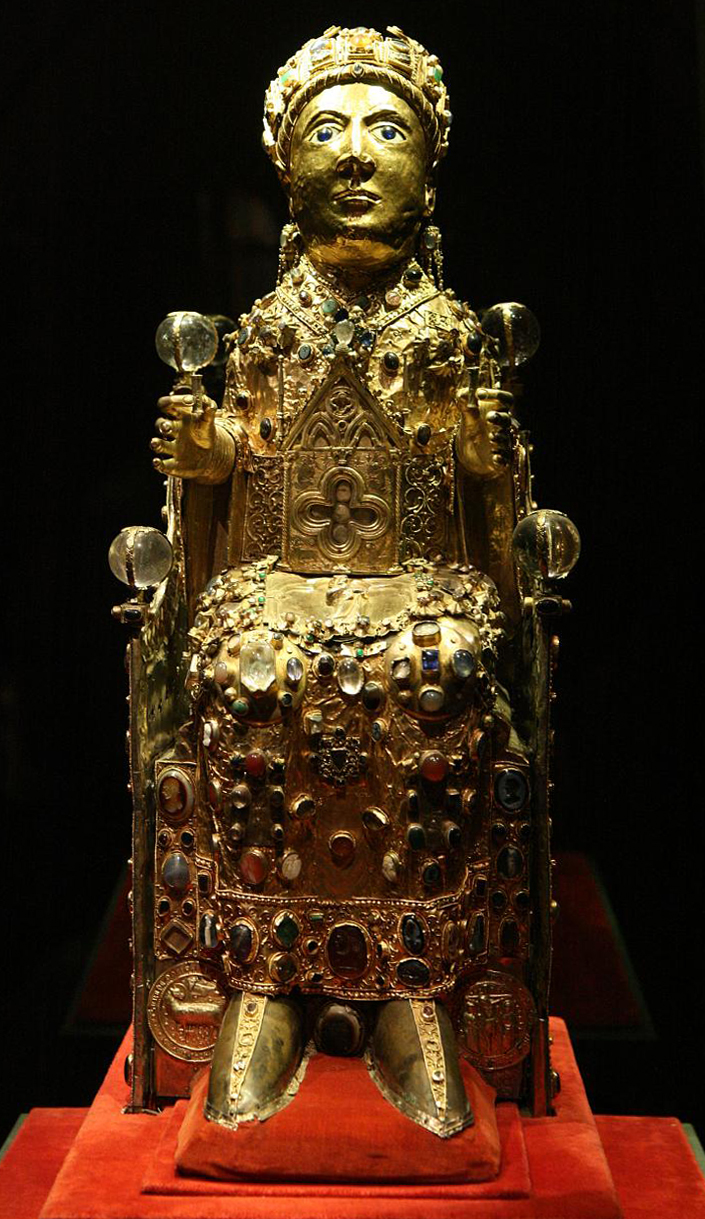
Church of Sainte-Foy. Conques, France. Romanesque Europe. Church: c. 1050–1130 C.E.; Reliquary of Saint Foy: ninth century C.E., with later additions.
FO: stone (architecture); stone and paint (tympanum); gold, silver, gemstones, and enamel over wood (reliquary)
FU: pilgrimage church
CN:
cross section, radiating chapels, ambulatory, tribunes, barrel vaults, columns
reliquary holding martyr/saint’s remains
relics (remains) of saint foy give the reliquary power
make pilgrimages
saint statue is a conduit
narrative sculpture + figural reliefs to educate illiterate
tympanum depicting Last Judgment: heaven (right; orderly, saints) vs hell (left; chaotic, sins), reminder of reason for church
CX: St. Foy was martyred at 12 by the governor of Agen in Gaul for refusing to sacrifice to pagan gods
Bayeux Tapestry. Romanesque Europe (English or Norman). c. 1066–1080 C.E.
FO: 230ft of embroidered wool on linen, made by nuns
FU: narrative of Norman conquest/Battle of Hastings, the events leading, and how William became the (first norman) king of england. Propaganda promoting him
CN:
75 scenes + latin inscriptions
hierarchy of scale, exaggerated gestures, continuous narrative
CX: Battle of Hastings was a conflict for the throne between Earl of Wessex (Harold) and Duke of Normandy (William)
Chartres Cathedral. Chartres, France. Gothic Europe. Original construction c. 1145–1155 C.E.; reconstructed c. 1194–1220 C.E.
FO: limestone, stained glass. Combo of high and early gothic styles
FU: place of worship, connection to god
CN:
rib vaults allow more light through windows (reminiscent of divine)
triforiums, jamb statues in both early/high gothic styles, bays
supports: flying buttress, piers, columnettes
many stained glass (rose) windows; changes light colors at different times, looks heavenly + reminiscent of divine
CX: originally romanesque, burnt in fire and rebuilt as gothic
Dedication Page with Blanche of Castile and King Louis IX of France, Scenes from the Apocalypse from Bibles moralisées. Gothic Europe. c. 1225–1245 C.E.
FO: illuminated manuscript (ink, tempera, and gold leaf on vellum).
FU:
convey a moral
ded: propaganda (divine right to rule), showing the owners of the bible (blanche of castile and king louis ix)
CN:
heavily illustrated bible passages from old/new testaments with commentary/explanations that allude to historical events (also illustrated)
ded: depicted in pose reminiscent of mary/jesus; god-given right to rule (“Fleur-de-lis crown”)
apoc: depicting story of john’s vision (sees everything till the end of time and god’s battle against evil)
CX: some anti-semitism (parallels between biblical bad guys and contemporary ones)
Röttgen Pietà. Late medieval Europe. c. 1300–1325 C.E.
FO: painted wood
FU: humanize suffering; relatability for medieval audiences
CN: more human, connection to the people. less ideal/glorified; emphasis on death, anguish, grief, suffering, rather than divinity.
CX: 14th century plague, war, famine, social strife
Arena (Scrovegni) Chapel, including Lamentation. Padua, Italy. Unknown architect; Giotto di Bondone (artist). Chapel: c. 1303 C.E.; Fresco: c. 1305.
FO: brick (architecture) and fresco; proto-renaissance
FU: private chapel built to appease god because of sin of “usury” (banking, charging interest)
CN:
40 major fresco paintings in 3 registers; narrative starting from joachim/anne (mary’s parents) till last judgment, following the life of mary and christ
Lamentation: depicting people and angels grieving over jesus’s death after crucification, emphasis through diagonal composition
CX: proto-renaissance is bridge between medieval and renaissance; artists start becoming important historically (no longer anonymous, have signatures), belong to guilds and learn through apprenticeship. few female artists.
Giotto is known for asymmetrical balance, single light source (chiaroscuro), depth, naturalism, emotion
Golden Haggadah (The Plagues of Egypt, Scenes of Liberation, and Preparation for Passover). Late medieval Spain. c. 1320 C.E.
FO: illuminated manuscript (pigments and gold leaf on vellum)
FU: read as part of a series of passover rituals
CN:
outlines passover rituals (food, music, stories, concept of freedom)
cross-cultural styles (jewish and gothic)
CX:
passover celebrates jewish freedom from slavery in egypt
cross-cultural more common in spain since jews/christians/muslims lived together
Great Mosque. Córdoba, Spain. Umayyad. Begun c. 785–786 C.E.
FO: stone masonry
FU: temple/church/mosque
CN:
hypostyle prayer hall, horseshoe arches, alternating red/white brick
spolia from the previous christian church
dome w squinches over mihrab
CX:
architecture based on previous regional traditions
visigoths: ruled before umayyad, after roman; commonly used horseshoe arches
Pyxis of al-Mughira. Umayyad. c. 968 C.E.
FO: carved ivory container
FU: box for cosmetics/potpourri
CN:
medallions w princely iconography surrounded by figures/animals
not aniconic = express umayyad caliphs’ political authority/legitimacy
CX: gift to then-18yo. al-Mughira (caliph’s son)
Alhambra. Granada, Spain. Nasrid Dynasty. 1354–1391 C.E.
FO: whitewashed adobe stucco, wood, tile, paint, and gilding
FU: residence/workplace for ruler/family, guards, court officials
CN:
three palaces: Comares, of the Lions, Partal
system of courtyards
prismatic forms, vault symbolizing heaven, carved decorative stucco
integral usage of water, showcasing practicality + beauty: gardens, fountains, canals, pools
CX: nasrid dynasty were the last muslims to rule in spain
Frontispiece of the Codex Mendoza. Viceroyalty of New Spain. c. 1541–1542 C.E.
FO: ink and color on paper; indigenous artists
FU: schematic diagram of tenochtitlan; information for spanish about aztecs
CN:
tenochtitlan divided into four parts by canals, parts align w cardinals
eagle/cactus: capital’s establishment
plants: agricultural fertility
aztec military victories shown in hierarchical scale. spanish showing them as impressive makes their own victory seem impressive
CX:
commissioned by first viceroy of Spain (Antonio de Mendoza), intended to send to king but it was taken by french pirates
overall codex contained info about organization/foundation, lords, tributes, daily life
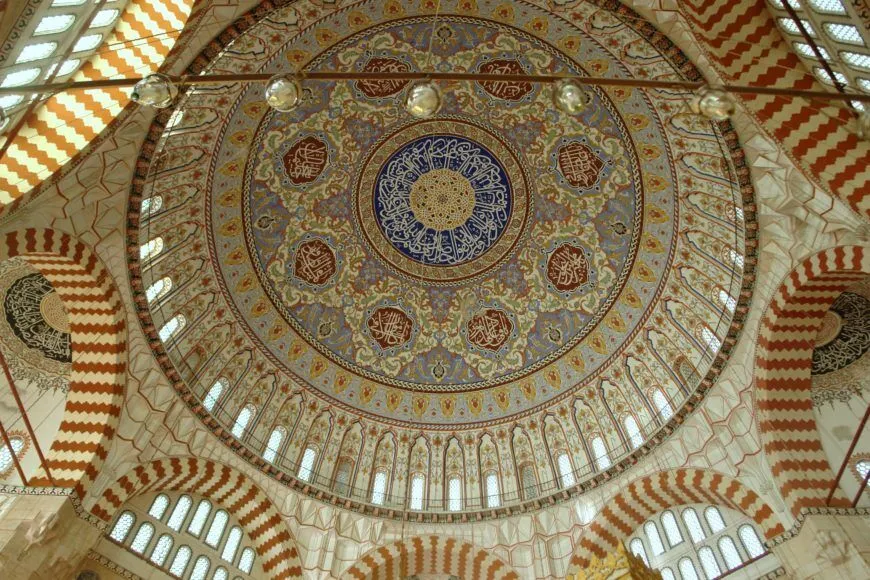
Mosque of Selim II. Edirne, Turkey. Sinan (architect). 1568–1575 C.E.
FO: brick and stone
FU: monument for the ottoman sultan expressing islam’s triumph, surpassing hagia sophia; proof of ottoman dominance
CN:
polychrome (multicolored) exterior
mosaics, tiles, “weightless” domes
islamic elements: minarets, mihrab (which can be seen froom any point)
large windows = otherwordly interior
geometric volumes, precise measurements/ratios
centrally planned
CX: based off hagia sophia, intended to be even more extravagant
Angel with Arquebus, Asiel Timor Dei. Master of Calamarca (La Paz School). c. 17th century C.E.
FO: oil on canvas
FU: enforce catholicism in pre-hispanic americas
CN:
military aristocratic androgynous angel mimicking sacred indigenous beings (often both sexes)
dress: mix of EU fashion w that of NA noble
association with god of thunder (NA saw guns as supernatural)
CX:
spanish colonization of south america
spanish inquisition (making everyone catholic)
Screen with the Siege of Belgrade and hunting scene. Circle of the González Family. c. 1697–1701 C.E.
FO: tempera and resin on wood, shell inlay
FU: siege of belgrade for viceroy’s male guests, hunting for his wife’s female guests
CN: hybrid colonial art form
traditional JP folding screen (biombo) with classical EU motifs
CX: in mexico??
The Virgin of Guadalupe (Virgen de Guadalupe). Miguel González. c. 1698 C.E. Based on original Virgin of Guadalupe. Basilica of Guadalupe, Mexico City. 16th century C.E.
FO: oil on canvas on wood, inlaid with mother-of-pearl (shiny shell)
FU: propaganda; spanish attempt to get NA to convert christianity
CN:
virgin mary appearing before an indigenous man (Juan Diego), telling him to build a shrine for her in his native tongue (nahuatl)
surrounded by mandorla of light
eagle on cactus: symbol of tenochtitlan establishment (syncretism)
reflective iridescent surface suggests heavenly/divine
CX: Juan Diego’s attempts failed twice before Mary told him to gather roses into his cloak, which when opened before the bishop revealed the image of Mary → shrine and basilica built on Hill of Tepeyac
Spaniard and Indian Produce a Mestizo. Attributed to Juan Rodríguez Juárez. c. 1715 C.E.
FO: oil on canvas
FU: casta painting
label social status of racially mixed based on amount of EU blood; support the idea of hierarchical categorization based on race/ethnicity
exoticize american way of life
CN:
each painting depicting a different “combo” of different race wife/husband and the race of their child(ren)
label at bottom explaining each combo
suggest cultural mixing thorugh interracial families and indigenous garments
CX:
lots of racial mixing in new spain, needed new social hierarchy rules
casta paintings come in large sets
meant for spanish/EU viewers
Portrait of Sor Juana Inés de la Cruz. Miguel Cabrera. c. 1750 C.E.
FO: oil on canvas
FU: emphasis Sor Juana’s intellectual status
CN: portrait of Sor Juana sitting in a library with many books
CX:
The Answer: defended her right as a woman to be a scholar
first feminist of Americas
became a nun to continue scholarly pursuits and not marry but was forced by church to give it up, signed document in her own blood
The Valley of Mexico from the Hillside of Santa Isabel (El Valle de México desde el Cerro de Santa Isabel). Jose María Velasco. 1882 C.E. Oil on canvas.
FO: oil on canvas; landscape painting
FU: celebration of mexican history/spirituality
CN:
pre-hispanic imagery; combination of national pride, aztec myth
the hill virgin guadalupe appeared on, her basilica
transitory moment between aztecs and mexico city (industrialization)
two volcanoes represent ill-fated love between aztec princess + warrior
CX: romantic art movement: sublime, awe-inspiring, celebrating nature
Chavín de Huántar. Northern highlands, Peru. Chavín. 900–200 B.C.E.
FO: Stone (architectural complex); granite (Lanzón and sculpture); hammered gold alloy (jewelry).
FU:
capital/temple/religious center, spiritual/sacrificial ceremonies
unify the people, pilgrimage site
calendar: agricultural production of potatoes/maize
CN:
“old” and “new” temple
darkness except for one specific place/time, light reflecting off mirrors
acoustics to project sound, allow “god” to speak to the whole building
Lanzon: sacred stone statue of the supernatural being for which it was built, human-feline hybrid
contour rivalry: purposely confusing to separate between believers/outsiders
CX:
duality significant to chavin (black and white stone)
constructed/used over many years